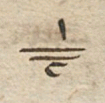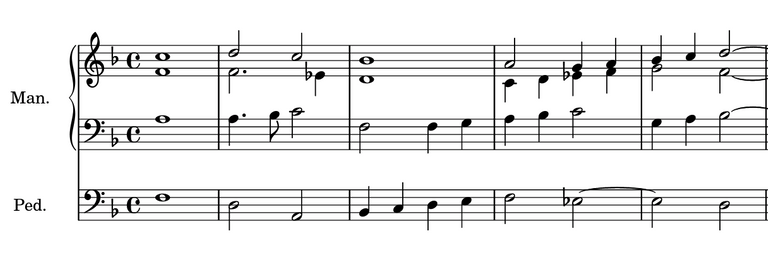German Organ Tablature explained (part 2)
German organ tablature is a music notation system, widely used in Northern Germany from roughly 1450 till early in the eighteenth century. It was primarily used to notate keyboard music, like harpsichord music and organ music. In the first part of this mini series I explained how pitch is notated in German organ tablature and made a start with how duration is notated. In this part I'll continue with explaining duration and the way of notating alteration. After that we'll be able to translate the example fragment, also used in the first part of this series:

As explained in the first part, pitch is notated by means of the note name, where the octave is diffentiated either by use of a capital letter, or by small lines above the note letter. Going from the lowest c of the organ keyboard to the higher ones, they are respectively notated as


 and
and  .
.
The duration of the note is written directly above the note letter and the octave indication. See for example the first c of the soprano voice in the example above:

The "1" above this note means it has the duration of a whole note (or semibreve). The half note (or minim) is notated as:

The quarter note (or crotchet) is notated as:

As in the modern way of notating musig music, each next halfation of the duration of the note is notated by means of adding an extra line to the symbol. For the eighth note (or quaver) and sixteenth note (or semiquaver) we have therefore the next two symbols:
 and
and 
A further halvation to a thirtysecond note (or demisemiquaver) is notated with five lines and the sixtyfourth note (or hemidemisemiquaver) is notated with six lines. These last occur very rarely. I've only yet encountered one occurence of sixtyfourth notes in German organ tablature.
Rests are notated using these same symbols. They are easily spotted as rests, because there is only the duration symbol and not a note letter.
When two or more notes of the same length occur sequentially in the same bar, the symbols for the duration are often combined to one symbol. This is much the same in our modern way of notating music where the beams of eight notes (and sixteenth notes, etcetera) are often joined to one beam, spanning the notes. Two half notes in succession are denoted as:

For 2 quarter notes, two eigth notes and two sixteenth notes, the combined symbols look like:

 and
and 
Finally, groupings of four exist as well and look like:

 and
and 
Larger groupings do not occur. Runs of more than 4 sixteenth notes are divided in groups of four or two. Larger groupings would quickly become unreadable, just as longer words become difficult to read. Like for example hemidemisemiquaver: I had to look a few times at it before I really saw what is spelled.
The way to extend a duration by half is the same as in the modern way of notating music: a dot. The symbol for a half note, combined with a dot, means a duration as long as 3 quarter notes. In the same way the symbol for a quarter note, combined with a dot, means a duration of three eighth notes. See for example the quarter note, with a dot:

The way these duration are used within one bar is a bit more flexible then in our modern notation. In a bar with the length of four quarter notes, it is possible to write the symbol for a half note on the spot of the fourth quarter note in the bar. In that case is just means that the note is tied over to the next bar. In German organ tablature ties can be used for the same purpose as well. It depends on the personal preference of the scribe which way of notating tied notes is used. And even within one composition both ways of notating can occur.
Alterations are notated with a downwards slur attached to the note letter. The slur has a meaning comparable with the sharp in modern notation. The note with a downwards slur has to be played a half note higher. German organ tablature has, except for the b which means b flat, no sign with a meaning comparable with the flat. It is, after all, a tablature and not a way to notate music in a music theoretical corret way. In other words, the tablature notates the keys to be played. As an example to explain this point more fully, consider the next figure:

This is the note letter d with a downwards slur attached to it. Therefore it means the note d sharp. But more specifically, it means the black key betweed the d and the e. The same symbol is therefore used for both d sharp and e flat. For a player it does not really matter, it is the same key after all. For a transcription of a composition from organ tablature to modern notation it is important: the transcriber has to think carefully whether a d sharp or an e flat is meant. The wrong choice makes it very hard to play the composition from modern notation. A d sharp in a composition in the tonal key E flat major in modern notation is for a player very confusing and quickly leads to playing errors.
Besides b flat, there are for symbols for black keys in German organ tablature, four note letters with a downwards slur attached: c, d, f and g. They look like:


 and
and 
As explained in the first part of this mini series the great octave has capital letters for the note names. The principal is the same: a downwards slur attached to the note letter. The manuscript from which the example material is taken only uses the raised f and g from the great octave:
 and
and 
We now have all the knowledge we need to transcribe the example shown above. The first bar was already shown in modern notation in the first part of this mini series. The soprano voice has two half notes in the second bar, d and c, leading to a whole note b flat in the third bar. The alto voice has a half note with a dot for the note f and a quarter note for the black key between d and e. Should it be notated as an e flat or a d sharp? The composition starts with a F major chord. A d sharp is highly unlikely in the tonal realm of F major, so in this case an e flat is meant. The e flat is followed by a whole note d. The tenor voice has a dotted quarter note a in the second bar, followed by an eighth note b flat and a half note c. The third bar then continues with a half note f and two quarter notes f and g. The bass voice has two half notes in the second bar, d and a, followed by four quarter notes in the third bar, b flat, c, d and e.
In a similar manner the fourth and fifth bar can be translated. The fourth bar has a tie in the bass voice to the next bar, and the fifth bar features ties in the three other voices. The complete translation of the fragment into modern notation looks therefore like this:

This concludes the second part of this mini series. The example shown is relatively straightforward. Often one encounters spots in manuscripts that are blotched, or where the note values used do not add up to a full measure (or add up to more than one measure), unexpected symbols are used, or where possibly/probably the scribe made a transcription error and the correct reading has to be guessed. Editorial decisions like this will be the subject of a third part in this mini series.
The fragment used is part of Ms Lynar B3, owned by the Staatsbibliothek Berlin - PK. A digital copy of this manuscript can be found at: http://digital.staatsbibliothek-berlin.de/werkansicht?PPN=PPN671074040
You can support me using Steem Basic Income

태그 작성 가이드라인 준수는 콘텐츠 관리와 글에 대한 접근성을 높이기 위해 반드시 필요한 절차입니다. ( It is an essential step to adhere tags guideline, manage content and make access better to your postings.)
스팀코인판에서 활용 가능한 태그는 크게 [보상태그 / 언어태그/ 주제태그]로 구분할 수 있습니다. 보상태그와 언어태그는 필수입니다.(Tags that can be largely grouped into [Main Community / Language / Topic] in community. The language and topic tags are required.)
(예) 한국어로 작성한 자유 주제 포스팅((E.g) Posting for free topic in English)
Resteemed, your post will appear in the next curation with a SBD share for you!
Your post has been supported and upvoted from the Classical Music community on Steemit as it appears to be of interest to our community. We also support jazz and folk music posts!
If you enjoy our support of the #classical-music community, please consider a small upvote to help grow the support account!
You can find details about us below.
The classical music community at #classical-music and Discord. Follow our community accounts @classical-music and @classical-radio or follow our curation trail (classical-radio) at SteemAuto!
Delegation links: 10SP, 25SP, 50SP, 75SP, 100SP, 150SP, 200SP, 250SP, 500SP, 1000SP
This post was shared in the Curation Collective Discord community for curators, and upvoted and resteemed by the @c-squared community account after manual review.
@c-squared runs a community witness. Please consider using one of your witness votes on us here
Thanks for the mention. Much appreciated!
You got a 36.17% upvote from @ocdb courtesy of @partitura! :)
@ocdb is a non-profit bidbot for whitelisted Steemians, current max bid is 15 SBD and the equivalent amount in STEEM.
Check our website https://thegoodwhales.io/ for the whitelist, queue and delegation info. Join our Discord channel for more information.
If you like what @ocd does, consider voting for ocd-witness through SteemConnect or on the Steemit Witnesses page. :)
Thank you for this. Tabulature has always been a mystery to me.
To me too. So you can guess my surprise when it turned out not so difficult to read...
You have to give me some hope of trying to read the tablature in the facsimile I have of Bach’s Orgelbüchlein. I suppose it’s no different decoding a foreign language and I am a linguist. The mystery will be no more.